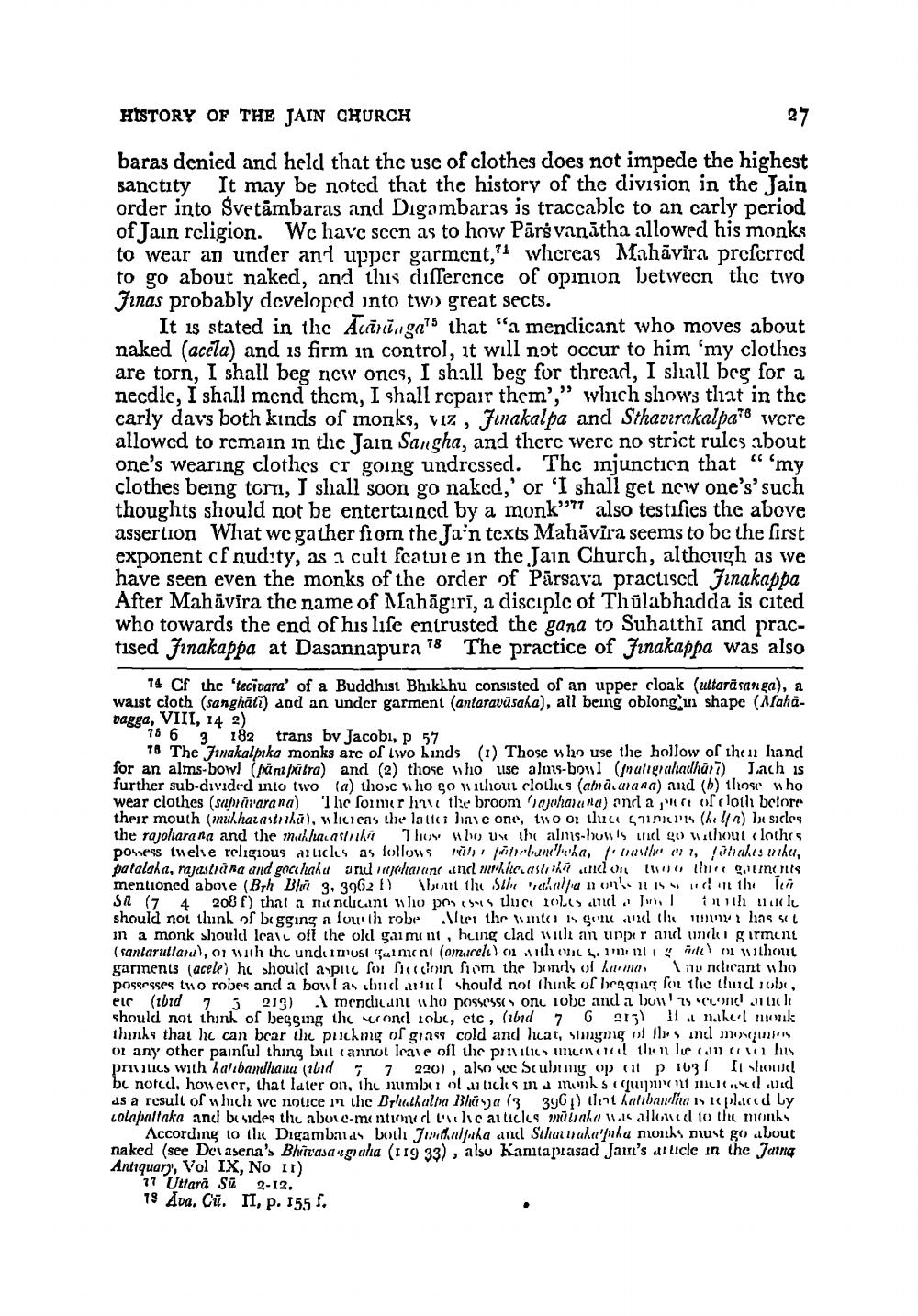________________
HISTORY OF THE JAIN CHURCH
27
baras denied and held that the use of clothes does not impede the highest sanctity It may be noted that the history of the division in the Jain order into Svetämbaras and Digambaras is traccable to an carly period of Jain rcligion. Wc have seen as to how Pārg vanātha allowed his monks to wear an under an upper garmcnt, whereas Mahāvira preferred to go about naked, and this difference of opinion between the two Jinas probably developed into two great sects.
It is stated in thc Acconigams that "a mendicant who moves about naked (acēla) and is firm in control, it will not occur to him 'my clothes are torn, I shall beg new ones, I shall beg for thread, I shall beg for a necdle, I shall mend them, I shall repair them'," which shows that in the early days both kinds of monks, viz , Jinakalpa and Sthavirakalpata were allowed to remain in the Jain Sangha, and there were no strict rules about one's wearing clothes cr going undressed. The injunction that “'my clothes being torn, I shall soon go nakcd,' or 'I shall get new one's' such thoughts should not be entertained by a monk"77 also testifies the above assertion What we gather fiom the Ja'n texts Mahāvira seems to be the first exponent cf nudity, as 1 cult fcature in the Jain Church, although as we have seen even the monks of the order of Pārsava practised Jinakappa After Mahāvira the name of Mahăgiri, a disciplc of Thūlabhadda is cited who towards the end of his life entrusted the gana to Suhatthi and practised Jinakappa at Dasannapura 78 The practice of Finakappa was also
74 Cf the 'tecivara' of a Buddhist Bhikkhu consisted of an upper cloak (ultarā sanga), a waist cloth (sanghāti) and an under garment (antaravāsaha), all being oblong in shape (Nahapagga, VIII, 14 2)
16 6 3 782 trans by Jacobi, p 57
78 The Fmakalpika monks arc of two kinds (1) Those who use the hollow of then land for an alms-bowl (franzpritra) and (2) those who use alms-bowl (Maligrahadhari) Jach is further sub-divided into two (a) those who go vithout clous (abi urana) and (b) those who wear clothes (suprizarana) 'l le former the broom lajoharunaand a rt of cloth bolore their mouth (mul halosū), ulicicas the latte laic one, no ou tlu 5711unis (helin) De sicles the rajoharana and the muchhaastohi Thuy ubo use the alms-huul lic go without clothes poness tuele religious allicles as follows mihi ruhha, s/n (1, lihakes uhu, patalaha, rajastiana and goc haha and olarant and make ashika shid on t o the guitments mentioned above (Bth Bln 3, 3962 ) Vuut the Sthe chatu non l i cet the Fun Sī (7 4 208 f) that a miniclicant who possastluci roles altul. Jul Auth! should not think of begging a louth robe htet thr tuinta egune th y has set in a monk should lcail off the old gamint, huing clad with an upper an uneko gurment (santaruliard), on with the undmusi qurmont (omurcle) 01 11th
11 will o without garments (acele) he should a pic for facoin from the bonus oi kaina nu nclicant who possesses tuo robes and a boulas bud 110 should not think of breguar for the thud robi, els (ibid 7 3 213) I mendilant who posSCSS on lobe and a bow'70 conclude should not think of begging uit rond oli, etc, (ibid 7 6 213) 11. make monk thanks that he can bear the puckmg of glass cold and luat, shingng of Ilse ind mereus or any other painful thing but cannot leave oll the prilic m oc then le can i valus priuilics with halıbandhanu (ibid 7 220), also see Scubimy op at p1031 It shoul be noted, however, that later on, the numbu ol al ticks mi a munh squirt inclus old as a result of which we notice in the Brhathulna Bhasa (3 396) tint halbandia is placed Ly colapalinka and besides the above-mentioned clic articles mülaka Was allowed to the monks
According to the Digambarus bolli Jumapiha and Stharahapka muuhs nust go about naked (see Devasena's Blutvusa gala (119 33), alsu Kantaprasad Jann's atlicle in the Marne Antiquary, Vol IX, No it)
17 Uttarā sū 2-12. 19 Ava. Cū. II, p. 155 f.




